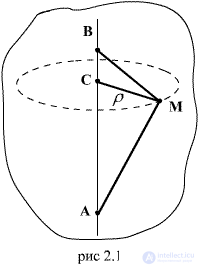Lecture
If in the process of movement of an absolutely rigid body (Fig. 2.1) its points A and B remain fixed, then any point C of the body located on the straight line AB must also remain fixed. Otherwise, the AU and VS distances would have to change, which would contradict the assumption of absolute hardness of the body. Therefore, the motion of a rigid body in which its two points A and B remain stationary is called the rotation of the body around a fixed axis, and the fixed line AB is called the axis of rotation.

Consider an arbitrary point M of the body that does not lie on the axis of rotation AB. When a solid is rotated, the distances МA and MV and the distance ρ of the point M to the axis of rotation should remain unchanged. Thus, all points of the body, rotating around a fixed axis, describe circles, the centers of which lie on the axis of rotation, and the planes are perpendicular to this axis. The motion of an absolutely rigid body fixed at one fixed point is called the rotation of the body around a fixed point — the center of rotation. Such a motion of an absolutely rigid body at each moment of time can be considered as rotation around a certain axis passing through the center of rotation and called the instantaneous axis of rotation of the body. The position of the instantaneous axis relative to the fixed reference system and the body itself may vary over time.
Comments
To leave a comment
Physical foundations of mechanics
Terms: Physical foundations of mechanics